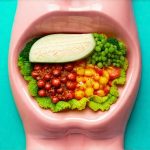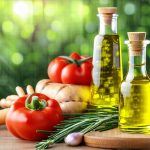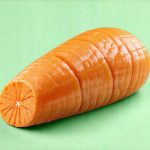Our relationship with food extends far beyond taste; it’s profoundly shaped by how things feel in our mouths and throughout our digestive systems. Often overlooked, food texture – encompassing everything from crispness to creaminess, chewiness to graininess – plays a surprisingly significant role in how efficiently (and comfortably) we digest what we eat. It’s not merely about enjoyment; the physical properties of food directly impact the mechanical breakdown process, enzyme accessibility, and ultimately, nutrient absorption. A mismatch between texture expectation and reality can even influence our perception of flavour and satiety, contributing to over or under-eating. Understanding this interplay is crucial for appreciating the complexity of digestion and potentially tailoring dietary choices to individual sensitivities.
Digestion isn’t a passive chemical process; it’s an active, mechanical one that begins with the very first bite. The teeth initiate breakdown, saliva lubricates and starts enzymatic digestion, and then the food travels down the esophagus into the stomach where further churning and acid exposure occur. Texture dictates how much effort is required at each stage. For instance, a tough piece of meat demands more chewing, stimulating greater salivary production and preparing the digestive system for a more substantial workload. Conversely, overly soft or liquid foods may require less mechanical breakdown but can sometimes ‘slip’ through digestion too quickly, potentially reducing nutrient absorption. The influence extends beyond the stomach; texture impacts intestinal motility – how food moves through the intestines – and even influences the gut microbiome.
The Mechanical Impact of Texture on Digestion
The initial stages of digestion are heavily reliant on mechanical breakdown. This isn’t just about making food smaller; it’s about increasing surface area for enzymes to work effectively. Different textures demand varying degrees of mechanical processing. Consider these examples:
– A crunchy apple requires significant chewing, stimulating saliva flow rich in amylase (an enzyme that breaks down carbohydrates).
– A smooth yogurt needs minimal chewing and is rapidly transported through the initial stages.
– A fibrous vegetable like broccoli necessitates prolonged mastication to break down cell walls and release nutrients.
This mechanical breakdown isn’t only performed by teeth. The stomach itself actively churns food, using peristaltic contractions to mix it with gastric juices. However, if food isn’t adequately pre-processed through chewing (influenced heavily by texture), the stomach has to work harder, potentially leading to discomfort or delayed digestion. The ideal scenario is a balanced approach: food that’s broken down sufficiently during oral processing eases the burden on the stomach and small intestine. Furthermore, the act of chewing itself can promote feelings of satiety – the sensation of fullness – helping regulate appetite. This is partly because chewing stimulates vagal nerve activity, sending signals to the brain about food intake. You might also want to explore how digestive enzyme tests can help understand these processes.
Texture also influences gastric emptying rate – how quickly food leaves the stomach. Highly textured foods tend to empty slower than smooth purees, providing a more sustained release of nutrients and potentially improving blood sugar control. However, this isn’t always desirable; individuals with gastroparesis (delayed stomach emptying) may find that highly textured foods exacerbate their symptoms. This highlights the individual variability in how texture impacts digestion – what works well for one person might not work for another. Understanding food texture influence can be a helpful starting point.
Texture and Gut Sensitivity: A Deeper Dive
The gut is a remarkably sensitive organ, and its sensitivity can be influenced by various factors, including food texture. For individuals with conditions like Irritable Bowel Syndrome (IBS) or functional dyspepsia, certain textures can trigger symptoms such as bloating, gas, abdominal pain, or altered bowel habits. This isn’t necessarily an allergy or intolerance; it’s often related to visceral hypersensitivity – an increased perception of normal gut sensations.
One key aspect is the role of FODMAPs (Fermentable Oligosaccharides, Disaccharides, Monosaccharides and Polyols). These are short-chain carbohydrates that can be poorly absorbed in the small intestine, leading to fermentation by gut bacteria in the large intestine. While not a texture issue per se, certain textures can exacerbate FODMAP sensitivity. For example, a smooth puree made with high-FODMAP ingredients might cause more rapid fermentation and symptom onset compared to the same ingredients presented in a chunkier form. The increased surface area of a puree allows for faster enzymatic action, potentially overwhelming the digestive system’s capacity to handle the FODMAP load. It may be helpful to investigate digestive panels if you suspect food sensitivities.
Another factor is how texture impacts intestinal motility. As mentioned earlier, different textures affect how quickly food moves through the gut. For some individuals, rapid transit time (often associated with smoother textures) can lead to diarrhea, while slow transit time (associated with tougher textures) can contribute to constipation. The key is finding a balance that promotes comfortable and efficient digestion. The ‘Low-FODMAP diet’ frequently recommends modifying texture alongside ingredient selection – for example, opting for cooked vegetables over raw ones or choosing smaller portions of fibrous foods. Recognizing antacid influence on the digestive system is also important to consider.
Navigating Texture Sensitivities: Practical Strategies
Identifying and managing texture sensitivities requires a degree of self-awareness and experimentation. It’s rarely about eliminating entire food groups but rather about adapting how those foods are prepared and consumed. Here are some strategies to explore:
1. Food Diary: Keep a detailed record of what you eat, noting not only the ingredients but also the textures involved (e.g., crunchy, creamy, chewy). Track any associated digestive symptoms.
2. Gradual Introduction: If reintroducing a potentially problematic food, start with very small portions and observe how your body responds. Begin with simpler textures before progressing to more complex ones.
3. Preparation Methods: Experiment with different cooking methods to alter texture. Steaming or boiling vegetables can soften them, while roasting can create a satisfying crunch.
Furthermore, mindful eating practices can be immensely helpful. Slowing down and thoroughly chewing food allows for better mechanical breakdown and provides the digestive system with more time to process each bite. Paying attention to your body’s signals – recognizing when you’re full or experiencing discomfort – can prevent overeating and minimize digestive stress. It is important to remember that texture sensitivities are highly individual; what works for one person won’t necessarily work for another.
The Role of the Gut Microbiome & Texture
The gut microbiome, the vast community of microorganisms residing in our intestines, plays a critical role in digestion and overall health. Interestingly, food texture can indirectly influence the composition and function of this microbial ecosystem. Fiber, often found in textured foods like whole grains, fruits, and vegetables, is a primary food source for beneficial gut bacteria. These bacteria ferment fiber, producing short-chain fatty acids (SCFAs) which have numerous health benefits, including reducing inflammation and strengthening the gut barrier.
However, the type of texture impacts how effectively these fibers are fermented. Highly processed foods with minimal texture often lack sufficient fiber to support a healthy microbiome. Conversely, overly fibrous textures can sometimes be difficult to digest, leading to excessive fermentation and gas production in sensitive individuals. A diverse diet rich in various textured plant-based foods is generally considered optimal for promoting microbial diversity. The mechanical breakdown of food during chewing also releases compounds that influence the microbiome; for example, breaking down cell walls releases nutrients that bacteria can utilize. You could gain further insight with a full body scan.
Texture Modification & Special Diets
For individuals with specific digestive conditions or swallowing difficulties (dysphagia), texture modification becomes a crucial part of dietary management. This involves altering the physical properties of food to make it easier and safer to consume. Texture Modified Diets are often categorized into levels, ranging from completely liquid diets to finely minced foods and everything in between.
- Level 1 (Pureed): Smooth, homogenous texture – no lumps or pieces. Suitable for individuals with severe swallowing problems.
- Level 2 (Mechanically Altered): Soft and moist foods that require minimal chewing effort. Examples include mashed potatoes or soft cooked fish.
- Level 3 (Regular Textured): Foods in their normal form, requiring moderate chewing.
These diets are typically prescribed by a healthcare professional – speech therapist or registered dietitian – based on an individual’s specific needs and swallowing assessment. It’s important to note that texture modification shouldn’t compromise nutritional value; careful planning is essential to ensure adequate intake of vitamins, minerals, and other essential nutrients. While these diets can improve safety and comfort for those with dysphagia, they also demonstrate just how profoundly food texture impacts our ability to eat and digest effectively. They also showcase the importance of understanding individual needs when it comes to dietary choices. Additionally, understanding diuretic disruptions can help manage digestive health.


















